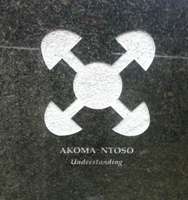Akoma Ntoso
|
The akoma ntoso symbol (as seen on the US African Burial Ground National Monument in New York City) | |
| Filename extensions |
|
|---|---|
| Internet media type |
application/akn+xml |
| Developed by | |
| Type of format | Legal informatics |
| Extended from | XML |
| Standard | Akoma Ntoso 1.0 draft |
| Open format? | Yes |
| Website | akomantoso.org |
Akoma Ntoso (Architecture for Knowledge-Oriented Management of African Normative Texts using Open Standards and Ontologies) is an international technical standard for representing executive, legislative and judiciary documents in a structured manner. It is a legal XML vocabulary and it suggests also a naming convention for providing unique identifier to legal sources based on FRBR model.
The term akoma ntoso means "linked hearts" in the Akan language of West Africa and for this reason it was selected for nominating this legal XML standard. The usual acronym is AKN, to designate the XML AKN format.
History
Akoma Ntoso started as an UNDESA project within the “Strengthening Parliaments’ Information Systems in Africa” and the core vocabulary was created mostly by two professors from University of Bologna. Later it became the main work package of the activities of the LegalDocML Technical Committee within OASIS. The Akoma Ntoso XML schema standard “defines a ‘machine readable’ set of simple technology-neutral electronic representations (in XML format) of parliamentary, legislative and judiciary documents”.
Akoma Ntoso is constituted by an XML document schema[1] providing sophisticated description possibilities for several parliamentary, legislative and judiciary document types (including bills, acts and parliamentary records, judgments, gazette, etc.). The work provided the basis for the OASIS Legal XML LegalDocumentML project.[2]
In 2010 European Parliament developed an open source tool (AT4AM) based on Akoma Ntoso for facilitating the production and the management of amendments.[3][4] Thanks to this project EU Parliament extended the application to Akoma Ntoso to other documents (e.g., proposal, transcript) and to other scenarios (e.g., translation process).
The "United States Legislative Markup" (USLM) schema for the United States Code (the US codified laws), developed in 2013, and the LexML Brasil XML schema for Brazilian legislative and judiciary documents, developed in 2008, were designed to be consistent with Akoma Ntoso.[5][6] Akoma Ntoso also was explicitly designed to be compliant with CEN Metalex,[7] one of the other de facto standards besides Akoma Ntoso,[8] which is used in the UK Statute Law Database.[9]
The United States Library of Congress created the Markup of US Legislation in Akoma Ntoso challenge in July 2013 to create representations of selected US bills using the most recent Akoma Ntoso standard within a couple months for a $5000 prize,[10] and the Legislative XML Data Mapping challenge in September 2013 to produce a data map for US bill XML and UK bill XML to the most recent Akoma Ntoso schema within a couple months for a $10000 prize.[11]
The National Archives of UK converted all the legislation in AKN in 2014 and the availability of bulk "moved the UK's ranking from fourth to first, in the 2014 Global Open Data Index, for legislation". [12]
Definition and aims
As official self-description, the standard
(...) defines a set of simple, technology-neutral electronic representations of parliamentary, legislative and judiciary documents for e-services in a worldwide context and provides an enabling framework for the effective exchange of “machine readable” parliamentary, legislative and judiciary documents such as legislation, debate record, minutes, judgements, etc.
Providing access to primary legal materials, parliamentary works and judiciaries documents is not just a matter of giving physical or on-line access to them. “Open access” requires the information to be described and classified in a uniform and organized way so that content is structured into meaningful elements that can be read and understood by software applications, so that the content is made “machine readable” and more sophisticated applications than on-screen display are made possible.
See also
- LexML
- Legal informatics
- Parliamentary informatics
- LegalDocML (OASIS LegalDocumentML)
References
- ↑ "Akoma Ntoso Github official repository - LegalDocML OASIS". github.com/oasis-open/legaldocml-akomantoso. OASIS - LegalDocML. Retrieved 2016-10-26.
- ↑ Gheen, Tina (23 April 2012). "OASIS Puts Akoma Ntoso on the Standards Track". Library of Congress.
- ↑ "AT4AM Video". EU Parliament.
- ↑ "AT4AM world". EU Parliament.
- ↑ "United States Legislative Markup: User Guide for the USLM Schema" (PDF). Office of the Law Revision Counsel. July 2013. Retrieved 25 August 2013.
- ↑ "LexML Brasil, Parte 3 - LexML XML Schema, version 1.0" (PDF). GT LexML. December 2008. Retrieved 7 February 2017.
- ↑ "OASIS LegalDocumentML (LegalDocML) TC". OASIS. Retrieved 25 August 2013.
- ↑ "Akoma Ntoso Updates". akomantoso.org. United Nations Department of Economic and Social Affairs. 29 April 2010. Retrieved 25 August 2013.
- ↑ "RDF/XML Format". Legislation.gov.uk. The National Archives. Retrieved 25 August 2013.
- ↑ Gheen, Tina (16 July 2013). "Library of Congress Announces First Legislative Data Challenge". Library of Congress.
- ↑ Gheen, Tina (10 September 2013). "Second Library of Congress Legislative Data Challenge Launched". Library of Congress.
- ↑ "OGP UK National Action Plan 2013-15" (PDF). The National Archives. 30 June 2015.
External links
- http://www.akomantoso.org/
- http://docs.oasis-open.org/legaldocml/akn-nc/v1.0/akn-nc-v1.0.html
- http://code.google.com/p/akomantoso/
- slaw.ca/2015/05/11 Akoma Ntoso v1.0
- akoma-ntoso-markup.challengepost.com, legislative-data-mapping (Akoma Ntoso converter)
